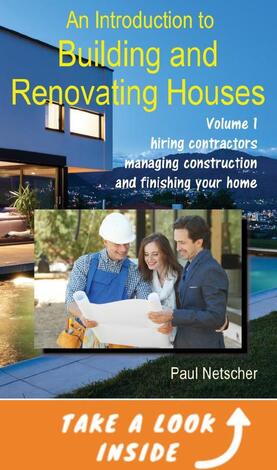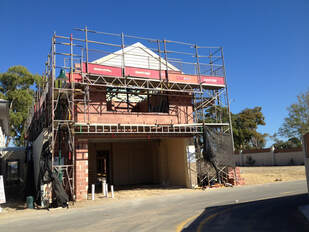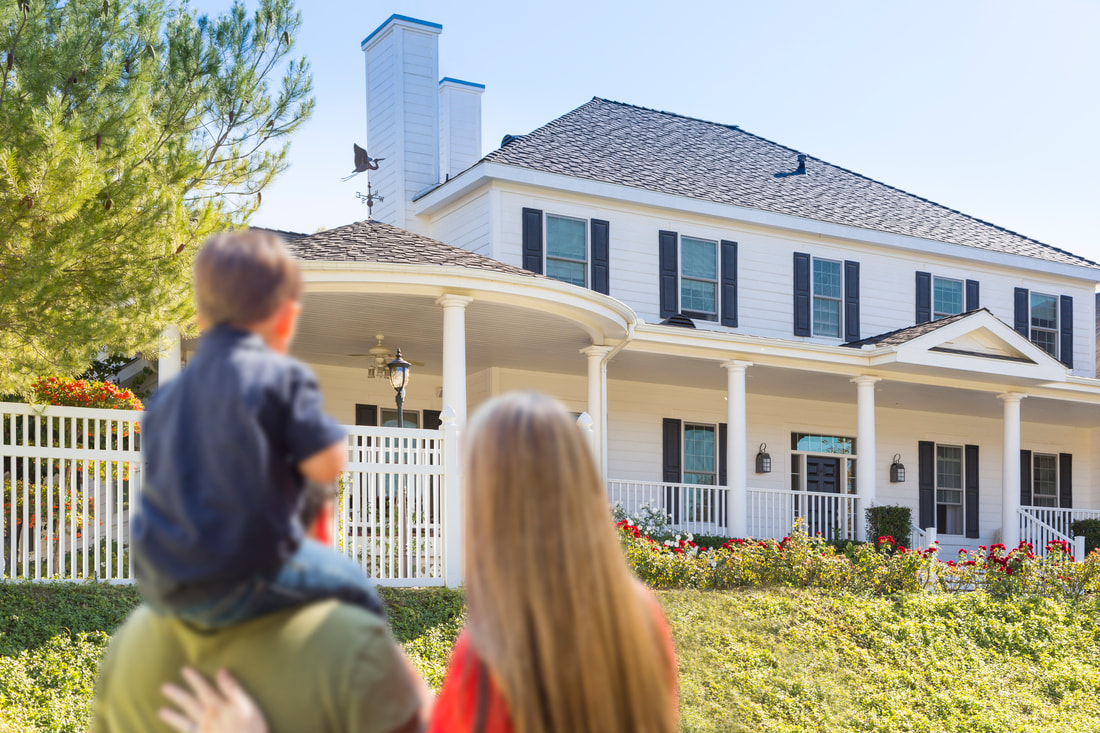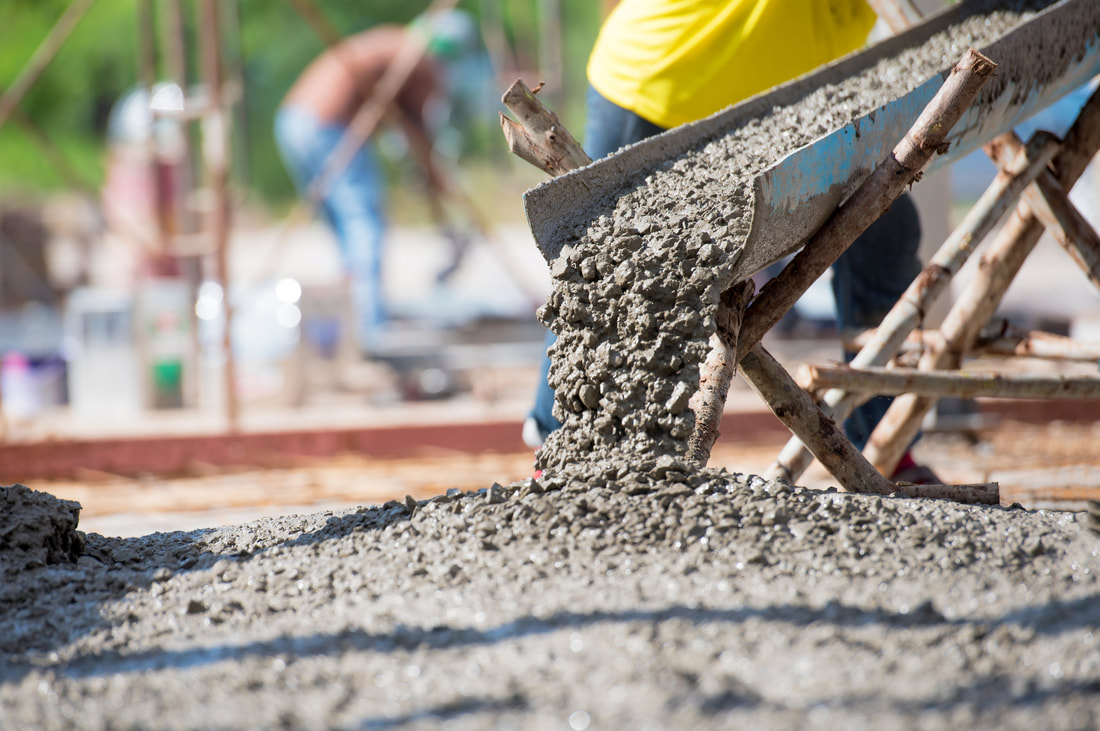Pets – an important part of many homes Most people have pets, such as dogs, cats, birds, or more exotic or larger animals. Important considerations for pets include:
 For more valuable tips and advice read: 'An Introduction to Building and Renovating Houses - Volume 1 Hiring Contractors, Managing Construction and Finishing Your Home' and'Volume 2 Finding Your Ideal Property and Designing Your Dream Home' This is an extract from: 'An Introduction to Building and Renovating Houses Volume 2' by Paul Netscher. Available in paper or eBook from Amazon.com, Amazon UK, Amazon CA, Amazon AU and all online bookstores. To read more © 2019 This article is not to be reproduced for commercial purposes without written permission from the author.
0 Comments
Concrete BasicsConcrete comes in different grades or strengths. Normally the engineer specifies the design strength of the concrete, which may vary for different parts of the building. Using concrete which is under strength will lead to problems with the structure, which could cause cracking and in the worst case catastrophic failure of the building. Using concrete of a higher strength or grade than required is more expensive. Concrete can be mixed on the building site, usually using a mechanical mixer. or it's ordered from a ready mix concrete supplier which delivers the concrete in concrete spinner/ready-mix trucks with revolving drums which continually mix the concrete. When ordering concrete it's important to specify the grade or strength and the amount of concrete required. Concrete is a mixture of cement, water, sand and stone. The strength of concrete depends on the ratio of cement to water. The more cement the stronger the concrete, while the more water the weaker the concrete. More water usually also means that the concrete shrinks more as it dries, which usually causes shrinkage cracks that are unsightly and which allows moisture to penetrate the concrete. Adding stone reduces the amount of water. But too much stone means that the concrete will be difficult to work with and there will be voids between the stones. It’s important to note that the stone should be clean and free of dust and dirt, since the dust and dirt will require more water, which will make for a weaker concrete unless more cement is added. Stone should be generally of a uniform size. Sand helps create the cement paste that fills the voids between the stones. Sand should be clean and free of contaminants, such as roots, sticks, rubbish and impurities. Not all sand is suitable for concrete. The best sand is a river sand which is of even grading. Sand which is too fine will require more water to wet it, and as already discussed more water means more cement or a weaker concrete. When the sand is very course the concrete may have voids, or be difficult to compact. If the sand is very wet then less water should be added to the mixture. Where possible sand for concrete should be kept dry and covered when there’s lots of rain. Sometimes, depending on the available sands and stone it may be necessary to blend two sands together. Sand, water, cement and stone must be well mixed so that the cement is evenly spread through the mixture and there are no lumps of material. The mixture is now known as concrete. Pouring ConcreteConcrete usually begins to set within four hours of being mixed. The time will be shorter when it’s very hot. The setting time will be extended when it’s cold, or when retarders (certain chemicals) are added. In fact, add sugar and the concrete will never set. So concrete should be placed and compacted as soon as possible. When concreting bigger structures it’s important to ensure that the first concrete placed doesn’t dry out before the next load of fresh concrete is added next to it. So it’s good practice when pouring slabs and beams to start pouring from one side of the structure, first bringing the concrete to the top surface, then steadily advancing with each new load of concrete, ensuring that the fresh concrete knits with the older concrete. If the new concrete is placed against older concrete that has already started to set it won’t join properly and there’ll be a ‘cold joint’ (visible joint) which is unsightly and weakens the structure, even meaning that the structure is unsuitable and should be condemned. It’s therefore critical to schedule concrete deliveries at the correct frequencies, so that there isn’t a long gap between trucks and also so that trucks are not standing, waiting for previous trucks to be offloaded, meaning that the concrete is already starting to set. You must place the concrete at a fast enough rate so that the concrete doesn’t start setting before fresh concrete is added. Concrete is best compacted by mechanical vibrators, or compactors, to ensure there’re no voids in the structure and to bring some of the concrete water to the surface. Concrete shouldn’t be over compacted. The concrete mixture should always be workable, having sufficient water, cement and sand so that it can easily flow into voids, between and around reinforcing steel, and so it can be readily compacted and worked with. However, construction crews should never add additional water to the concrete mix to make it more workable. Remember the golden rule, more water equals weaker concrete! Only the mixing crew should add more water, plus the required additional cement. As the concrete starts to set the top surface should be finished and smoothed off. The final finish will depend on what will come on top of the concrete. Floors that will have a carpet or vinyl floor finish will be required to have a smooth (‘steel float’) finish. Floors that will be covered with tiles may only require a rougher finish. However, in all cases it’s important to ensure that the top surface of the concrete is finished to the correct required levels without dips and humps. A smoother finish takes longer, so can be more expensive. A very smooth finish could be unsuitable when other layers are added, say when a screed is to be placed over the concrete. Protecting Your Newly Laid ConcreteConcrete shouldn’t be allowed to dry out too quickly which will cause shrinkage cracks and slow down the strength gain. Fresh concrete should be cured for seven days so that it retains moisture. This curing should start as soon as it has been worked smooth and set. Curing of concrete can be done by:
Conclusion - Ensuring your Concrete Building Structure is SoundIt's important that those working with concrete ensure that the correct grade of concrete is used. As soon as the concrete is mixed, or it's delivered to the project, it should be poured or placed into the structure. Concrete that's too dry or that has too much stone is difficult to work with and won't always get into all the corners and around the reinforcing in the structure. Concrete that's too wet will often have excessive cracks in it when it dries. Care should be taken not to add additional water to the wet concrete since this weakens the concrete. Adding additional water usually means you should also add more cement. Concrete must be thoroughly compacted and care must be taken to ensure it's finished to the correct level and worked smooth. Using the wrong grade of concrete, adding additional water, using unsuitable sands or contaminated materials, not compacting the concrete correctly, allowing the concrete to set before the next batch of concrete is added, or failing to cure the concrete correctly, could result in excessive cracking and a weakened structure which will cause problems for your new house.  For more valuable tips and advice read: 'An Introduction to Building and Renovating Houses - Volume 1 Hiring Contractors, Managing Construction and Finishing Your Home' and'Volume 2 Finding Your Ideal Property and Designing Your Dream Home' This is an extract from: 'An Introduction to Building and Renovating Houses Volume 1' by Paul Netscher. Available in paper or eBook from Amazon.com, Amazon UK, Amazon CA, Amazon AU and all online bookstores. To read more © 2019 This article is not to be reproduced for commercial purposes without written permission from the author. Help the environment and save money with these tips for your home Image courtesy of xedos4 at FreeDigitalPhotos.net Image courtesy of xedos4 at FreeDigitalPhotos.net People are starting to become more environmentally-conscious. Then again, the growing concern for the environment is understandable. After all, global warming is starting to impact many. Some areas are becoming hotter and dryer while other areas are impacted by more frequent and more severe storms. But being environmentally conscious isn’t only about helping our planet, it’s also about helping our pockets. Home energy bills are rising, and they are only going to increase further – especially if we have hotter summers. Wouldn’t we all like to cut our household energy bills? But there are other benefits, building smart houses often means that we have cooler more livable homes in the heat of summer and warmer houses in winter. Who wouldn’t want a more comfortable home? Since more people are demanding eco-friendly and environmentally sustainable homes, designing and building a home with these features will make it more appealing to buyers in the future should you decide to sell your home. So, the best place to start being more conscious about the environment is our very own homes. Let’s take a look at what you can do to have a home that’s friendlier to the environment. Go for solar power Admittedly, installing solar panels requires a more significant investment than most people are comfortable with. But the sun will always be the best source of free and clean energy we’ll have. And while it can be expensive to install, powering your home with sunlight will be much cheaper in the long run. It will also help reduce your dependence on fossil fuels, which is already a huge favor for the environment. Adding battery storage (which is becoming cheaper) will allow you to become totally independent from utility providers. Use nothing but LED light bulbs LED light bulbs use up to 75% less electricity. And they also last for many years, unlike incandescent bulbs that are very inefficient and have much shorter lives. Add skylights Even when you’re using LED light bulbs you’re still using electricity to power them. If the sun is up, why use light bulbs to illuminate your interiors when you can let sunlight into your home via skylights? Aside from its apparent eco-friendliness, installing skylights also brings a myriad of health benefits, as sunlight can help us sleep better and boost our body’s production of Vitamin D as well. Water-efficient plumbing We live in a world where manufacturers are doing their best to design products that are more eco-friendly. The plumbing products industry, for example, is now selling everything from water-efficient shower-heads to toilets that use a lot less water than older models. Installing these products in your home will help minimise water wastage and reduce water bills without impacting how you live. Many people live in water scarce areas and water is becoming a valuable product which needs to be saved and protected. Houseplants The air quality in your home is a good indicator of how eco-friendly your home is. For cleaner indoor air, you might want to put houseplants inside. They filter the air and provide additional oxygen as well. Use only sustainable materials Sustainable materials are the way to go if you’re building or remodeling your home. Green materials like bamboo and cork, for example, would be suitable for your flooring. It would also be great if you use solvent-free natural products which are less harmful to your family and the environment. Buy energy-efficient appliances The single biggest indicator that you’re buying an energy-efficient appliance is the "Energy Star" logo. AC units, refrigerators, and other home appliances that bear that mark use 10 to 50 percent less electricity than those without the logo. Conclusion - building eco-friendly homesWhenever we do something eco-friendly, we aren’t just helping the planet, but we are often helping our family by creating a more liveable home, and of course we are also helping our pockets by cutting our utility bills. So why not become friendlier to the environment, starting inside our homes. About The Author Victoria Grace is the Content Specialist for Nucleus Construction, a Phoenix-based company that specialises in remodeling and building custom homes. When not writing, she enjoys reading books and riding her motorcycle.  For more valuable home design tips and advice read: 'An Introduction to Building and Renovating Houses - Volume 1 Hiring Contractors, Managing Construction and Finishing Your Home' and'Volume 2 Finding Your Ideal Property and Designing Your Dream Home' Read this story - a very expensive lesson for the house building contractor, both in cost and loss of reputation. A stressful and expensive experience for the home owners.
Read: The estate where neighbours began to vanish It's almost more frightening than a ghost story.  Last week I discussed decisions that influence your choice of home and it's design. Designing the best house for you and your family In this article I discuss how your family and your lifestyle impact choices and what you should consider. What does your partner and family want or need in a new homeEmbarking on designing and building a new house, or renovating your home, is going to be even more difficult if there isn’t agreement with your partner. Thousands of design and home decorating decisions will have to be made. Establishing some common ground as to the size, general layout, overall architectural theme and the location of your new home is essential. Failure to discuss your thoughts and to understand your partner’s point of view could lead to one of you being unhappy with your new or renovated house, or even both of you. Not agreeing principles as the home design progresses could lead to designers and contractors being pulled in two directions, inevitably leading to changes while the house is being constructed, which will be costly. Even more costly will be changes after construction of your home is complete. Understand that some compromise from both sides will be necessary, but always ensure that these compromises aren’t going to result in an architectural mishmash of ideas, that looks terrible and doesn’t satisfy anyone. So, at an early stage visit homes together, look at the same magazines and review house plans. Narrow down the choice of house plans and styles to those that you both like – which might not have been your first choice for your new home. Where you disagree over designs, colours and features with your partner, argue the case logically with the pros and cons. Be prepared to change your mind if you’re wrong, or make adaptions where necessary. You may involve the children in some of the home design and planning processes, but you shouldn’t be too side-tracked by what they want. Yet, it’s important to consider their changing needs and how the house can be adapted to fit these needs. So, a home for children under five could be different to a home for children between five and thirteen, while older children will have different needs. It’s important to provide them space in the house which can be changed and adapted. Space to play, space to study and space to entertain friends. Taking account of your lifestyle and tastes (and your family’s) in your home designYour lifestyle will dictate the requirements of your house, it's design, layout, finishes and style. So consider some of the following questions and how they'll influence your design decisions, how the answers will influence what should be included or excluded in the house design.
Conclusion - getting your home design rightProbably your new home can't have everything you would like it to have. After all there's usually only so much money and so much space that you have available. But anyway, would you really be happy with a huge mansion that costs a fortune to run, clean and maintain? But it is possible to balance the needs of your partner and family with your likes and needs, while keeping your new home build project in budget. Carefully consider what you like and dislike as discussed in my previous article. Collect home design and decorating ideas from various sources. Don't just rush for the first plan or style that appeals to you. Really understand you lifestyle and make sure that the plan, layout, design and finishes of your new home will fit your lifestyle and the way you live. We are all different, so not every house will satisfy your needs or lifestyle. Take time to plan and design your house so that it will satisfy your and your family's needs when you're living in it. Get the design of your new house right before starting construction. Changes during construction or after the house is complete will be expensive. So many questions and decisions might seem overwhelming and confusing so it's important to take a logical approach. Make lists of likes, wants, needs, dislikes and disagreements. Tick off items as they're taken care of. Don't make rushed decisions which you could regret when you move into your new home.  For more valuable home design and renovation tips and advice read: 'An Introduction to Building and Renovating Houses - Volume 1 Hiring Contractors, Managing Construction and Finishing Your Home' and 'Volume 2 Finding Your Ideal Property and Designing Your Dream Home' This is an extract from: 'An Introduction to Building and Renovating Houses Volume 2' by Paul Netscher. Available in paper or eBook from Amazon.com, Amazon UK, Amazon CA, Amazon AU and all online bookstores. To read more © 2019 This article is not to be reproduced for commercial purposes without written permission from the author. What kind of house do you want to live in? What houses do you like? Before designing that new house, renovations or additions, it’s wise to sit down and decide what you want. Do you want a house or an apartment, how many bedrooms, the number of bathrooms, what size rooms, do you need a garden and how big, do you require parking for vehicles and does this need to be undercover and secure, where is your desired location, what is the style you would like, and what kind of fixtures, fittings and finishes are you looking for in your new home? It’s useful to visit houses that are for sale – even if they’re in the wrong location or out of your price range. They frequently offer opportunities to gather ideas – to see what features, styles, layouts and houses you like and don’t like. Even if you don’t like a house don’t simply rush out, but take your time looking around. Understand why you don’t like the house – are there particular features, styles or layouts that put you off? Are there some features that you do like – what and why? Always keep in mind the various prices. Understand why some houses are more expensive than others. Know what can be purchased with your budget. You may want to live in a multi-million dollar dream home that’ll grace the cover of popular home and garden magazines – yet for most of us this is a dream that isn’t going to happen, and anyway it's usually unnecessary and doesn't guarantee that you will end up liking living in the home. Look through house and home magazines to obtain ideas for interior finishes and architectural styles. Visit display showrooms that offer various options for tiles, lights, bathroom fixtures and kitchens. See what can be achieved so that you and your family can live happily in the home. Scan the internet for ideas and styles that you like. Always try and understand why you like something, or why you don’t like it. Take photographs, make notes, collect brochures, collect pictures from magazines and the internet. Create folders of ideas. What do you need in your new home?Now this is where the voice of reason needs to step in. There’s often a competition between what you want and what you need. You may want an expensive sports car which, however, could be impractical if you require the car to take the family on vacation. The same goes for your house. We usually all want the best, state of the art, iconic, architect designed structures and yet we probably only need the basics. Though, you mustn’t confuse the word basics with producing something of poor quality, or of skimping on costs so you have a house that’s not fit for purpose. To go back to the car analogy, you may not need a sports car, but you’ll need a car that’s reliable, safe, that can accommodate the family, is comfortable and which retains resale value when you decide to sell it. You want to enjoy using the car. So too with your house, you want somewhere that you can enjoy living in, that will satisfy your and your family’s requirements, and that will be appreciated by others when the time comes to sell and move on. And yes, inevitably you will eventually sell and move on. Some home renovation projects are started on a whim – you saw something, a feature or style, and thought it would look nice. How often have you bought an item of clothing only to find when you got home that it wasn’t the right size, or wasn’t an item that you needed? Our closets are filled with items of clothing that have never, or seldom, been worn. Unfortunately building or renovating your house costs lots more money, and can’t simply be changed when you find it’s not suitable. You can sometimes return an article of clothing because it’s the wrong colour or size, but, increasing the size of a room, or ripping out floor tiles because you don’t like their colour isn’t so easy and often costs lots of money - if it can be done at all. So you simply shouldn’t one day get out of bed and decide you’re going to renovate and extend your house, then immediately call a contractor, or worse, get out the tools from the shed and start smashing down walls. It’s therefore important before embarking on a new home construction or renovation project that you list all the items required from your new house. This would then normally be the minimum set of requirements for the house. Indeed, during this process of deciding what you like and dislike, what you need and don't want, that you may find that your current home already fulfils all your family’s needs and there’s no need to undertake major renovations or build a new house. Maybe all your house needs are a few minor repairs and a new coat of paint. Perhaps even throwing out that accumulated junk, putting in some additional storage, rearranging the furniture and replacing items that are unsuitable could be the simple solution – in a future articles I'll discuss some simple solutions to improving your home. These are also discussed in more detail in my book 'Building and Renovating Your Home With Your Eyes Wide Open' It’s always important to also consider your future needs, which might be characterised by short term and medium term needs. So for instance, if there’s a new baby on the way you may need that extra bedroom quite soon. If you’re planning to have more children, then maybe you need to be considering more than one extra bedroom. On the other hand, if your children are about to leave home, your current house which could seem very crowded right now, may in a few years suddenly have surplus rooms, so would it be wise to be adding an additional bedroom that may only be needed for a year or two. Conclusion - Making the right design decisions for your home construction projectYour early design decisions and choices can live through the life of your home build and renovation project and come back to haunt you if they’re bad decisions. It’s important not to be impulsive, but rather to carefully consider what you and your family require, what you like, what you don’t like, what you can afford and what your abilities are. You should be clear as to why you want to build a new house, or why you’re going to renovate. In future articles I will discuss taking cognisance of what your family wants and needs, lifestyle considerations impacting your design choices and the impact of architectural styles - all ensuring that you design the best house for you and your family.  For more valuable home design and renovation tips and advice read: 'An Introduction to Building and Renovating Houses - Volume 1 Hiring Contractors, Managing Construction and Finishing Your Home' and 'Volume 2 Finding Your Ideal Property and Designing Your Dream Home' This is an extract from: 'An Introduction to Building and Renovating Houses Volume 2' by Paul Netscher. Available in paper or eBook from Amazon.com, Amazon UK, Amazon CA, Amazon AU and all online bookstores. To read more © 2019 This article is not to be reproduced for commercial purposes without written permission from the author. |
AuthorI’m a construction professional, author of several successful construction management books, and a home owner. I’ve made mistakes in construction management, I’ve seen others make mistakes, but importantly I’ve had multiple successful construction projects and I’ve learned from the mistakes. I want to share these lessons and my knowledge with you. Also available from:
Amazon Au, Amazon DE, Amazon ES, Amazon CA, Amazon IT, Amazon FR, Amazon NL, Amazon India and 'An Introduction to Building Houses - Volume 2 Finding Your Ideal Property and Designing Your Dream Home'
Archives
July 2024
CategoriesWe welcome genuine comments, especially comments that add additional information to the subject matter in the article. We however reserve the right to remove inappropriate comments, which includes comments that have nothing to do with the subject, comments that include inappropriate language, and comments that are an advertisement for a product or company, or which include an advertising link. Comments must be in English. We will not enter into discussion on why a particular comment was removed.
|






 RSS Feed
RSS Feed


